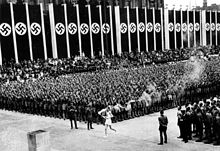Carl Diem
At the age of twenty, he was hired by the German Sports Authority for Athletics (the Deutsche Sportbehörde für Athletik, or DSBfA), and a year later was elected to its board of directors.
In the summer of 1914, Diem and Lewald were planning their spectacular 1916 Olympiad when World War I erupted, and the Berlin games were subsequently cancelled.
Diem and Lewald, who had returned to their sports-organizing duties, lobbied successfully to win permission for a German team to compete in the 1928 games in Amsterdam.
[6] With support from the state, Diem also founded the Deutsche Hochschule für Leibesübungen, a school dedicated to the study of the science of sport.
He attended the 1932 games in Los Angeles, carefully observing the host city's preparations and facilities, committed to meeting or outdoing the American accomplishment in Berlin four years later.
[3] Instead of a balanced budget, which Diem had proposed in late 1932, new sporting facilities were built, the underground train extended to the stadium site.
Lewald had to arrange himself with Hans von Tschammer und Osten, the new President of the National Olympic Committee, but even more so with Interior Minister Wilhelm Frick (whose Ministry had been in charge of elite sport since 1914.
[14] The Nazi establishment went out of their way to assure the world that "non-Aryan" participants were being allowed to compete – and kept Jewish Olympic hopefuls in national training camps.
Brundage returned to the U.S. and, defeating the boycott's supporters, helped to ensure that a full American athletic delegation would attend the games in Berlin.
On 30 June 1936,[3] the first torch-flame was kindled in Olympia, Greece, in the ruins of the Temple of Hera, by 15 robed "virgins," using a concave mirror focusing the sun's rays, all under the supervision of a "high priestess."
It was carried to the Acropolis in Athens for a special invocation, and then relayed along the 3,422-kilometer distance to the Olympic stadium in Berlin by an equal number of young Aryan-looking runners, each of whom took the flame a single kilometer.
On its way, the flame passed through Bulgaria, Yugoslavia, Hungary, Austria and Czechoslovakia; those countries, and Greece itself, would all be under Nazi domination within ten years.
[19] The event was filmed by Hitler's favorite director, Leni Riefenstahl, and branded with the giants of German industry: the lighting-mirrors were made by the Zeiss corporation, and the torches themselves, fueled with magnesium to prevent them from going out in bad weather, were constructed by Krupp, the huge steel and munitions conglomerate that armed Germany for both world wars.
[20] The final leg of the relay was completed on 1 August by Fritz Schilgen, a German electrical engineer and national champion runner, who ran into the stadium and lit the Olympic cauldron to open the games.
Even the ritual kindling of the flame with a mirror on the grounds of the Temple of Hera remains virtually intact as the official method of starting the relay.
In March 1945, as the Red Army was closing in on Berlin in the final weeks of the Second World War, Diem staged another event in the city's Olympic stadium.
Addressing a rally of thousands of teenage Hitler Youth, Diem exhorted them to defend the capital to the death, in the spirit of the ancient Spartans.
When Bernhard Zimmermann, who had emigrated to Scotland in 1938, declined to become the Rector of a new National Sport College in the British Zone (Cologne), Diem received the job.
His career in national sport preceded the Nazi regime by decades, and he was appointed to organize the 1936 games years before Hitler decided to put his own indelible mark on the Berlin competition.



